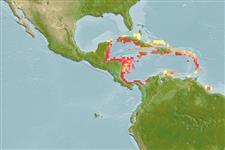Actinopterygii (ray-finned fishes) >
Mugiliformes (Mullets) >
Mugilidae (Mullets)
Etymology: Joturus: Taken from the Greek letter "iota" = the least or in the very small quantity + Greek, oura = tail (Ref. 45335). More on author: Poey.
Environment / Climate / Range
Ecology
Marine; freshwater; brackish; pelagic-neritic; catadromous (Ref. 51243); depth range 10 - ? m. Subtropical; 22°C - 25°C (Ref. 36880), preferred 27°C (Ref. 107945); 30°N - 7°N, 112°W - 65°W
Central America: Bahamas and Greater Antilles and the Atlantic and Pacific slopes of Central America and Colombia.
Size / Weight / Age
Maturity: Lm ? range ? - ? cm
Max length : 61.0 cm TL male/unsexed; (Ref. 9321); common length : 25.0 cm TL male/unsexed; (Ref. 9321); max. published weight: 3.3 kg (Ref. 40637)
Adults inhabit the upper reaches of rivers but enter brackish waters where spawning probably occurs. An important food fish in some areas. Herbivorous and scrapes algae from stones on the bottom with its fleshy lips, although sometimes eats prawns (Ref. 36880). Oviparous, eggs are pelagic and non-adhesive (Ref. 205). Migrate from the upper reaches of rivers during months of high rainfall to the sea-river transition zone to spawn (Ref. 13802).
Life cycle and mating behavior
Maturity | Reproduction | Spawning | Eggs | Fecundity | Larvae
Harrison, I.J., 1995. Mugilidae. Lisas. p. 1293-1298. In W. Fischer, F. Krupp, W. Schneider, C. Sommer, K.E. Carpenter and V. Niem (eds.) Guia FAO para Identification de Especies para lo Fines de la Pesca. Pacifico Centro-Oriental. 3 Vols. FAO, Rome. (Ref. 9321)
IUCN Red List Status (Ref. 115185)
CITES (Ref. 94142)
Not Evaluated
Threat to humans
Harmless
Human uses
Fisheries: subsistence fisheries
More information
ReferencesAquacultureAquaculture profileStrainsGeneticsAllele frequenciesHeritabilityDiseasesProcessingMass conversion
Tools
Special reports
Download XML
Internet sources
